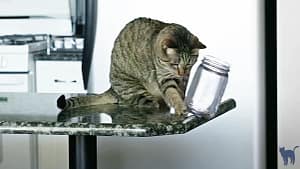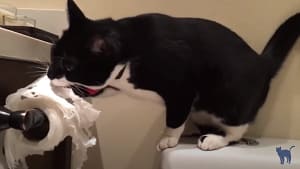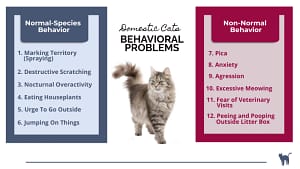Cats can communicate in many sophisticated ways that are unique to felines. They are creatures that can experience a wide range of emotions. The most common include anger, fear, anxiety, satisfaction, curiosity, disappointment, and many others.
They express themself in 4 ways:
- Through touch, physical contact with each other;
- Visually, using body postures and movements;
- Through chemical scent signals, which are the most common way felines interact;
- Through vocal communications, meowing, and a long variety of cat sounds.
- Can CATS communicate with each other?
- How do they perceive what’s around them?
- How do cats communicate with humans?
All animals have their own language and way of communicating. There are many different types of animal communication, some of which we still do not fully understand.
Despite all the years of study and research, we are always finding new information about how animals send messages to each other. And cats are no exception.
If you share your home with cats you will surely agree with me that our pets can share their emotions and needs with us. This is why it feels like they are talking to us in many cases, right?
Have you ever wondered if cats can communicate with each other? and how cat communication works?
Wonder no longer. I’ve done the research and I’m excited to break it down with you. Keep reading to discover how cats communicate with each other once and for all.
How Do Cats Communicate?
Cats, like humans, express themselves in many ways. Not all of their communication is as clear as a meow. Some kinds of feline communication are so subtle that if you blink, you’ll miss them.

In nature, cats are solitary animals who rarely seek the company of other cats even if they can live together in friendly groups.
If you’re wondering how this connects to the topic of how cats interact with one another, it all comes down to their social structure.
Cats have intricate relationships with other cats to “keep the peace.” These ties are formed as a result of their interaction with other cats in their family group as well as with cats outside their family group.
In this sense, there are four types of cat communication:
- Tactile: through touch;
- Visual: through body postures;
- Chemical: through scent (Spraying and Rubbing);
- Vocal: through cats’ noises.
#1 Tactile Cat Communication: Touch

Touch is very important to felines. Not just between mother cats and their kittens, but also within the same family of cats. This form of tactile communication is related to friendly, loving actions. It helps to increase social bonding. Some of the most common “touches” are:
- Hitting the nose
- Hitting the head
- Head to head,
- Head to the body,
- Body to body,
- Rubbing and
- Massaging our laps with paws
Cats rub against each other to exchange pheromones from their scent glands. A typical friendly behavior. These scent glands are located on their cheeks, jaw, and near their tail. When they rub those parts on another cat (an object or another animal) they transfer a scent only other cats can smell.
In this way, cats communicate that they’re comfortable in each other’s company. This is a cat’s way of showing love and liking. A cat kissing the top of another cat’s head, for example, is one way to comfort an unhappy cat.
Why do they do that?




Scientists believe this is a way to greet humans and say they are happy to see them. It could also be a way of spreading their scent and marking their territory (or both).
Like rubbing, there is another way cats claim territory, which is spraying. While the former has no negative impact, spraying causes many issues when done inside a house. Bad smell and dirty walls are things you’d probably want to avoid if it starts doing it.
If you are interested in learning how to prevent this behavior… or are looking for a solution since it’s happening in your house, check out this product review on how to stop your cat from spraying at home.
# 2 Visual Cat Communication: Body Postures
Cats use subtle and dramatic body language to have “conversations” with other cats. Through postures and gestures, they state their current mood or desire. Each body part is used to send different messages.
Cats communicate with their tail, head, face, and ear postures. Even the eyes and whiskers have a lot to say. These messages might include:
- Friendly signals between cats;
- Anxious cat body language;
- Cat aggression and fear signs.
Friendly Signals Between Cats
If your cat looks at another cat and blinks, for example, it is communicating that it is paying attention to him or her. Most experts refer to it as “cat kisses.”
You can “smile” at your cat by looking at it in the eyes and gently blinking. You’ll notice that it will usually do it back at you. That is its way of telling you “I love you”.
If the cat lies down, turns on itself, and shows its belly, it means it is very confident in the presence of the other cat and is showing him the most vulnerable part of itself.


Another expression of friendliness is a cat is standing up, head up and its tail being held high for all to see.
Anxious Cats' Body Language


Cat Aggression and Fear Signs


Cat owners who are unfamiliar with the basics of cat physical cues are frequently confused by what is going on. They miss “conversations” between cats that may show friendliness, fear, anxiety, or aggression.
This complex mix of visual cues needs a thorough explanation. If you want to go deeper into Cat’s body language, you can find more information here. (the cat bible)
# 3 Chemical Cat Communication: Scents (Spraying and Rubbing)
This is the most common way that felines communicate with one another. Yet it is the most difficult for us to understand.
Why? Because humans only have 5 million olfactory receptors in their noses, while cats have 200 million.
This implies they are 40 times more capable of sensing the scents than we are.
We know it’s a form of communication. But translating the cat’s smell vocabulary into something meaningful to humans remains an unexplored opportunity.
Cats, in fact, have a specific organ for this purpose known as Vomeronasal or Jacobson’s organ. It is located behind the upper incisors.

The cat inhales the smell and analyzes it with that organ as if it were tasting it. This makes them more sensitive to smells and pheromones than humans.
What Exactly Are Cats’ Pheromones?
Pheromones are chemical substances made by cats. They release them into the environment to communicate with other felines. Pheromones also have the function of triggering physiological or behavioral changes in the cat’s receptors.
Pheromones play an important role in feline communication. They can say the cat’s gender, age, health, and willingness to mate, as well as the age of the scent mark itself.
These olfactory signals include:
- Urine,
- Excrement, and
- Scratch marks.
Urine is one they use the most since it persists the longest.
Cats also have glands that produce smells on their paws, cheeks, lips, forehead, tail, flanks, and around their rectum, besides to a specific smell organ.

Cat owners frequently misinterpret the cues. When our cats spray, pee, or scratch furniture, we perceive it negatively.
We assume that they are malicious. It’s as if they’re doing it on purpose to irritate us. However, this understanding is incorrect.
Cat behavior expert Pam Johnson-Bennett explains that they do it for reasons like
- Identifying members of the same family (or colony);
- Defining territory;
- Creating familiarity;
- Announcing reproductive status;
- Learning more about unfamiliar cats in the environment;
- Self-soothing;
- Bonding with other cats; or
- A form of covert aggression.
Is your cat spraying in your house for no (apparent) reason? You can find information about a product that can help you solve this big problem HERE.
When your cat scratches on objects to mark them, it also leaves scent gland deposits in its paw pads, thus claiming its territory.
For example, a cat claims its territory by scratching at an object. By doing so, it leaves a scent on it that comes from a gland in its paw pads, which other cats can sense.
Are You Having Cat Scratching Issues?
TIP: It’s essential to have enough scratching posts and trees in strategic locations around the house. In this way, you can prevent it from scratching your furniture.
Are interested in having a deep dive into this topic? These articles could interest you:
# 4 Vocal Cat Communications: Cats’ Noises

Not all cats communicate with sounds though. Many prefer to remain silent, a predatory instinct they never get rid of despite becoming domesticated.
Cats REMAIN QUIET when they feel vulnerable and hide both physically and emotionally.
It mostly happens in 3 circumstances:
- when they are sick;
- when they are in pain; or
- when they are giving birth.
Only in some particular situations, cats communicate with other cats through sounds. This happens when they are away from home at night, for example.
Sounds are useful for addressing messages across great distances or when visibility is limited. We’ve all heard the nightly cat sound concerts in the spring season.
What’s odd is that cats use vocal communication only with humans, while they use the other types of cat communication more with their kind.
That’s what anthrozoologist John Bradshaw says in his book “Cat Sense: How the New Feline Science Can Make You a Better Friend to Your Pet”. He proved it by seeing how feral cats do not meow nearly as often as domesticated house cats.
Meows appear to be a vocalization they use to look for human attention so they can eat or get outside.
Scientists believe it is some kind of manipulative strategy to get what they want.
As Nicholas Dodman of Tufts Cummings School of Veterinary Medicine argues:
“Cats can learn which noises are most effective in getting their owners to do what they want”. (Robins 2014).
But when it comes to more serious help… they prefer remaining silent, so they can hide their vulnerability to others. This is why you won’t see them meowing a lot when they are sick, in pain, or giving birth.
Different meowing as well as intensity and loudness, represent the cat’s emotional and physical needs. Loud meowing conveys anxiety and fright. Whereas less intense meowing conveys confidence and contentment.
Many specialists and behaviorists agree that cats can make over 100 different noises. We’re still a long way from having them all understood. However, the following are the most common:
# 1 Meow
# 2 Trill
# 3 Chatter
# 4 Purr
# 5 Caterwaul
# 6 Growl
# 7 Howl or Yowl
# 8 Hiss
# 9 Scream or cry
Friendly Sounds Between Cats
Anxious and Aggression Cat Vocalizations
Cats will growl, howl, or hiss to alert other cats to back off when interacting with them. These “concerts” are performed in an escalating manner and can be raised and lowered in pitch.
It is the cat’s way (along with its body language) to avoid a physical confrontation at all costs.
Pleasure and Happiness Cat Sounds
Every cat owner’s favorite sound is a purr. Cat purring is a complex vocalization that needs more research. Yet, we know that adult cats usually purr when they are happy.
But on rare occasions, cats purr when they are not feeling well.
As with body postures, vocalizations can convey different states of mind:
This complex combination of sounds needs a deeper explanation. Would you like to learn more about cat vocalization? You don’t need to look any further; you’re covered.
Check out the following article:
What Do Different Cat Noises Mean? [9 Most Commons Sounds Explained]
Do Cats Meow to Communicate With Each Other?
The simple answer is yes. However, this affirmation needs a more thorough explanation.
Meow is the first sound newborn kittens make. Since they are born with their eyes closed, they meow to tell their mothers they need help. They do it most when they are cold, hungry, or struggling to find their mother’s nipples.
But as wild cats develop into adults, these vocalizations disappear.
Yet, in some cases, cats use vocalizations to communicate with other cats. According to experts, this happens when they want to communicate across great distances or when visibility is limited.
A perfect example can be when there’s a female cat in heat that is locked at home, looking for a partner to mate with.
However, experts do not always have all of the answers… These two adorable kittens appear to meow just to comfort one another. What do you think?
Do Cats Understand Each Other’s Meows?
Do Cats Understand Human Language?
Cats do not have the cognitive abilities to interpret human language. But they do recognize when you speak to them.
In other words, cats understand human language in the same way that we understand meowing. It’s similar to interpreting your cat’s language by “reading” their body postures and movements.
Do Cats Know Their Names?
Recent research on cat behavior has shown that cats pay attention when you call them by their name. Then it’s up to them whether they want to respond to your call. Cats might find themselves… already busy.
A cat’s motivation and current emotions are likely to influence how and when they respond. When you aren’t rewarding them with treats or play sessions, the sound of their name isn’t strong enough to make them move.
- Is your cat basking in the sun?
- Is your cat resting in its favorite bed?

That is when your fancy pet is more likely to choose what they are doing now over what you want them to do.
(and who can blame them?)
Conclusion
These are the four ways that cats communicate with each other and express themselves: through touch, visually, olfactory, and with sounds.
This fascinating topic is still a long way from being fully understood. Mapping the entire feline language and dictionary needs more research. Especially in the chemical cat communication field since it’s beyond our sense of smell capabilities.
Still, the more we study how cats interact with each other, the more we learn about them. We are more aware of how they are like us, and at the same time of the significant differences.











